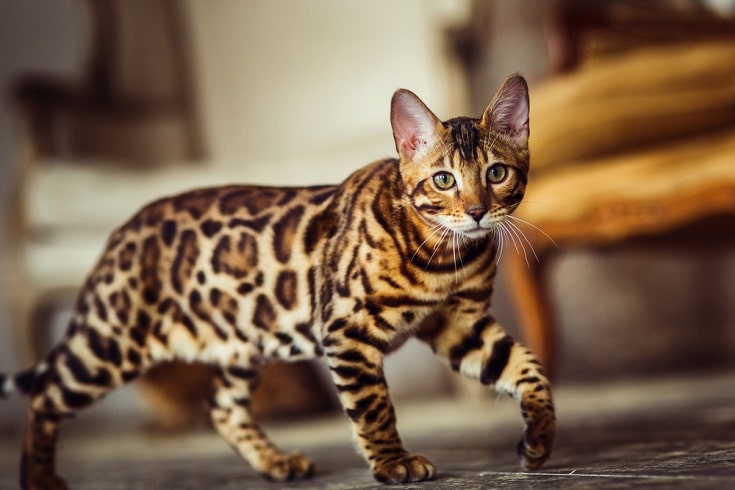The Bengal cat is a uniquely beautiful animal with all the domestic cat attributes that cat lovers know and love combined with spectacular patterns and colors that imitate their wild ancestors. Two significant aspects differentiate modern Bengal Cats: their coat color and their coat markings. The colors and patterns have a large degree of variance and intensity, but the basic breed-recognized colors are brown, silver, and snow, and each can be patterned with either marbling, spots, or a combination of both.
With all these variations in colors and patterns and the inevitable combinations, it can be challenging to know where to start in finding the right Bengal to bring home. We’ve compiled this comprehensive guide to Bengal colors and patterns to help you identify and choose from the varieties available.
The 6 Bengal Cat Colors
Bengals have three standard breed-recognized colors, but they can also come in various “unrecognized” colors. While these colors are found in most domestic cats, the combination of color and unique patterning makes for a visually stunning animal. The spots or marbling can be in various shades and intensities and display a beautiful contrast not found in other domestic cat breeds.
The standard recognized colors of Bengals are brown, silver, and snow, and unrecognized colors can include charcoal, blue, and melanistic (solid black), as described by TICA.
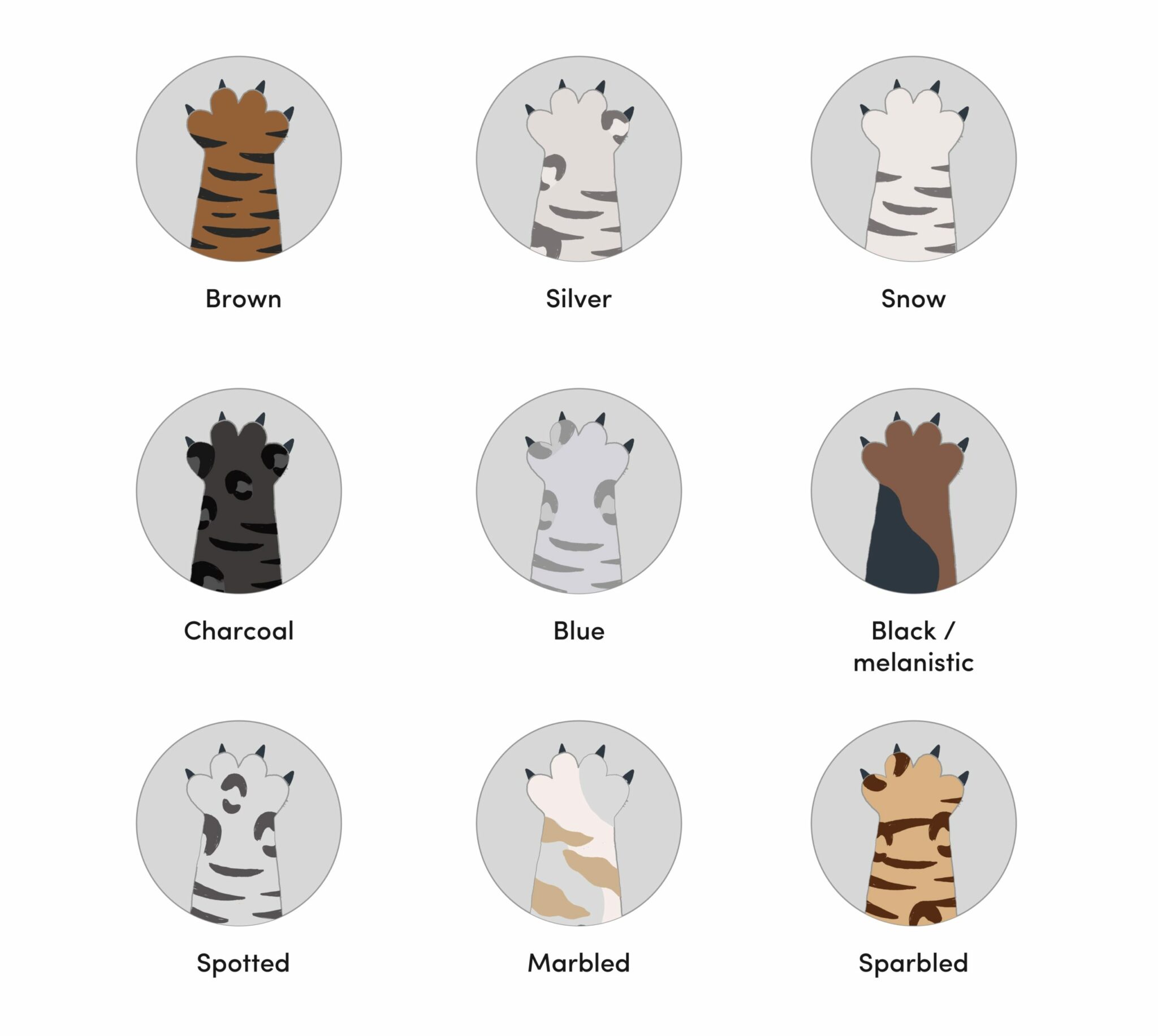
1. Brown Bengal Cat
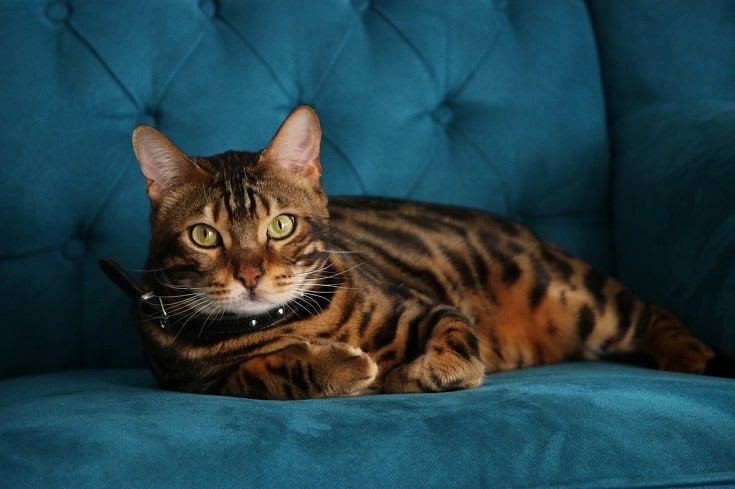
Brown Bengals are one of the most popular varieties and have color range variations that include descriptions like golden, creamy, honey, caramel, red, and orange, with an orange-brown or butter coat being the preferred standard base coat. This base coat is usually beautifully contrasted with dark chestnut or black markings, which can be varied solid rosettes or marbling, typically a dark outline with graduated shades of brown inside.
This color variety, whether with spots or marbling, is called the Leopard Bengal due to its close resemblance to the big cat. They usually have green or golden eyes and a solid-black tipped tail.
2. Silver Bengal Cat
Silver Bengals have an almost pure white base coat that can vary from white to a steel-like silver shade contrasted by black and gray spotted or marbling patterns. This can also include charcoal and blue shading in the base coat and patterns, but it should never include brown or golden tones on the feet or face. They will usually have green or golden eyes and a solid black-tipped tail.
3. Snow Bengal Cat
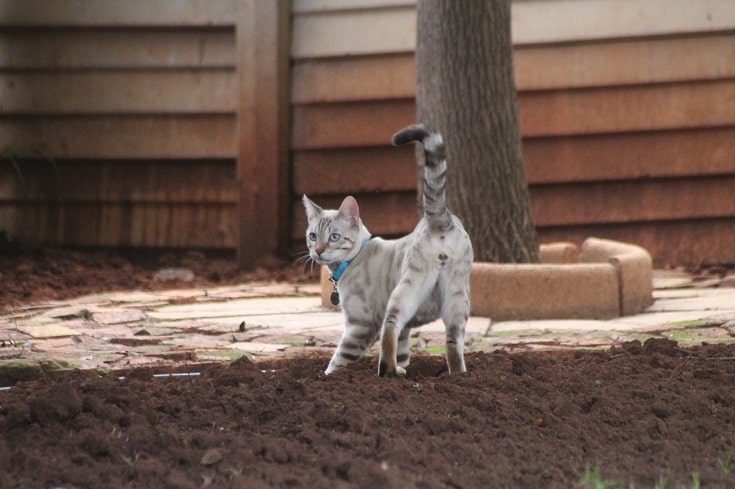
The Snow Bengal comes in three variations, and contrary to their name, their base coat is not pure white.
- Seal lynx point. These Bengals are the lightest snow variants and are born without markings or faintly visible markings. They have a creamy-white base coat contrasted by brown, gray, or tan spots or marbling. These beautiful cats resemble snow leopards and are the only Bengals with ice-blue eyes.
- Seal mink. Seal mink Bengals usually have a light brown, cream, or ivory base coat with a darker brown, caramel spotted, or marbled pattern. They usually have a blue-green or aqua eye color.
- Seal sepia. As the darkest of the snow variants, seal sepia Bengals have light chocolate or tan brown base coats with various shades of brown, tan spotted, or marbled markings. They are typically found with green or golden-brown eyes.
Non-recognized Bengal Cat Colors
Although Bengal competition standards do not officially recognize these colors, they are just as striking as standard Bengal color variants. They are typically caused by recessive genes that can crop up among standard litters.
4. Charcoal Bengal Cat
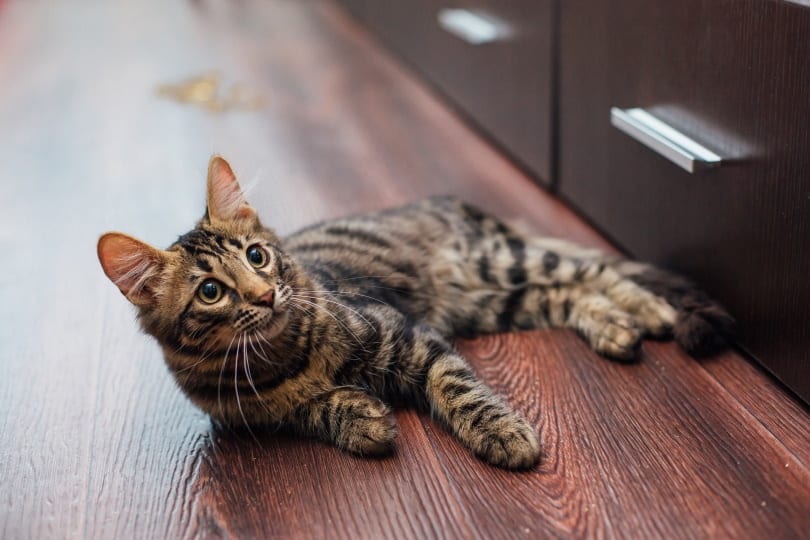
This color variant is more of an additional masking layer than a separate color, as it is usually described as a “ghost” layer that comes out on top of Bengal’s standard base coat. Charcoal layers can be seen in standard color variations and are described as charcoal silver, charcoal brown, etc. They typically have a dark face mask, with a thick, dark stripe running down the length of their back, known as a “cape.”
5. Blue Bengal Cat
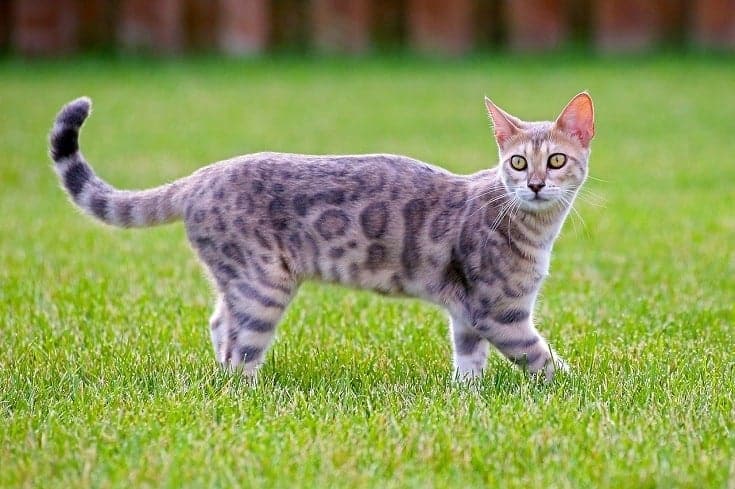
Blue Bengal variants are rare and highly prized. They have a steel-blue or powder-blue base coat with occasional cream tones and a dark, gray-blue marbled or spotted patterning. They typically have hazel brown or green eyes.
6. Black or Melanistic Bengal Cat
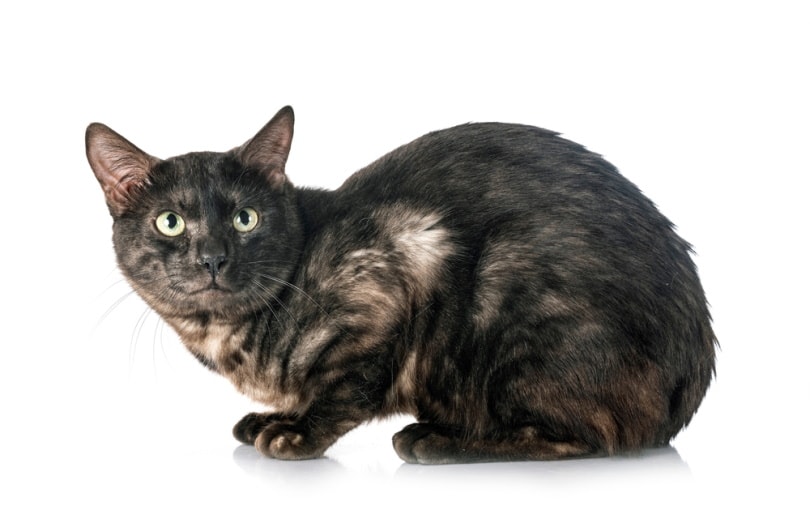
These prized cats are revered for their resemblance to black panthers and typically have a base coat with marbled or spotted patterned colors that are almost indistinguishable, giving them an almost solid black appearance. The patterns on the cats are usually called “ghost markings” because they are virtually invisible except in bright sunlight.
The 3 Bengal Cat Patterns
While a Bengal’s markings typically fall into two distinct categories—spotted and marbled—there is a wide variety within each pattern category that Bengals can display. Spotted variants were the first recognized pattern type, with marbled cats coming soon after.
7. Spotted Bengal Cat
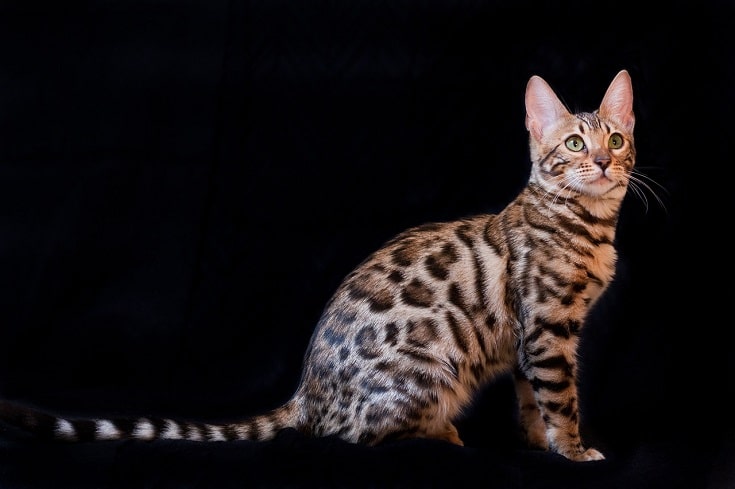
A spotted Bengal is the most popular and recognizable pattern. The spots are usually small to medium-sized patterns scattered all over the cat’s coat, with large, dark spots on a light background being the most highly prized variation. The spots can appear in many colors and shapes, each with a distinct category described by breeders.
- Single spotted. This is the simplest variation of spotted Bengal, but just as eye-catching. The pattern consists of small monochrome spots spread on a contrasting base coat without a gradient in color inside the pattern. The spots are similar to a cheetah in that there is no second color to the small spots, and they are usually a dark contrasting color, like dark grey, brown, or black.
- Cluster rosettes. Rosette patterns are spots with two contrasting colors distinct from the base coat. Cluster rosettes are the least dramatic version, consisting of a center color darker than the base coat punctuated by small clusters of darker-colored spots.
- Paw-print rosette. Like cluster rosettes, paw-print rosettes consist of dark spots edging one side of the second color but never enclosed. They resemble small paw prints strewn across the cat’s back.
- Clouded rosette. These rosettes are spaced close together and are large, with subtle signs of a second color around the edge.
- Doughnut rosette. This pattern is defined by spots surrounded by an even darker colored outline. This is one of the most popular spotted patterns, giving the cat a leopard-like appearance. They can also appear as what is known as pancake rosettes, which have thinner outlined rings than doughnut rosettes.
- Arrowhead rosette. Arrowheads are a fairly uncommon pattern that can be monochrome or outlined, with varying degrees of a rosette. They are triangular-shaped patterns that point toward the back of the Bengal and can vary significantly in size and density.
8. Marbled Bengal Cat
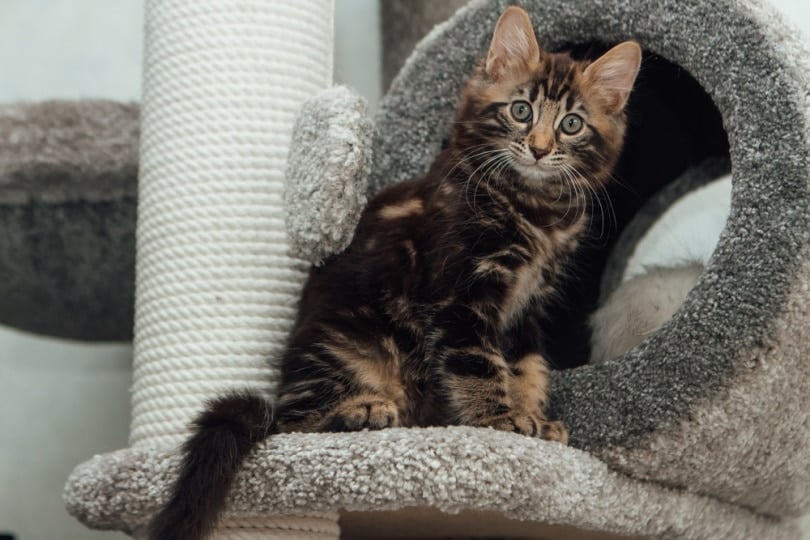
The marbled pattern is a series of swirls and stripes with a flowing, random pattern of two or more color variations. This patterning can come in various shapes and colors, which are typically divided into four distinct categories by breeders.
- Horizontal Flowing. These markings are like those seen on a Boa Constrictor, flowing horizontally along the cat’s spine.
- Reduced horizontal flow. Also known as “high-acreage,” this pattern has a high ratio of background to markings and is prized due to its close resemblance to wild cats.
- Sheeted flow. This pattern has a high ratio of markings to the base coat, with little negative space. This can be especially prominent in some Bengal kittens, and it can take up to 2 years before the patterns properly “open up.”
- Chaos pattern. The chaos pattern lives up to its name and is a dramatic amalgamation of all of the above. It consists of chaotic swirls, flows, and colors, punctuated by occasional splashes of color and patterns.
9. Sparbled Bengal Cat
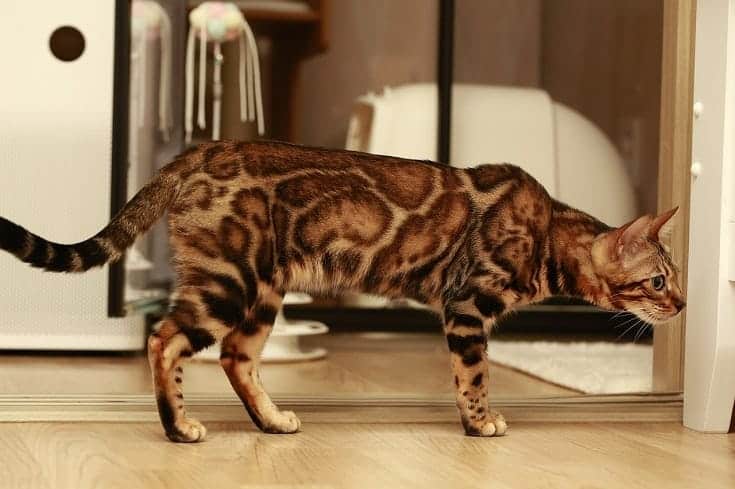
A sparbled coat combines spotted and marbled varieties, creating a marbled and rosette clashing of markings. Although it is not an officially recognized pattern, it is still beautiful to behold, especially when there is significant negative space between the chaotic patterns. This coat can become dramatic when mixed with clouded or charcoal markings.
Additional Bengal Cat Characteristics
If all that variation is not enough for you, here are a few more!
- Glitter. While not all Bengals have it, some have a shiny, glitter-like appearance to their coat. This sparkling, shimmering effect is eye-catching, to say the least, and is visible even in low light. This unique trait was first seen in Bengals, and although it is beautiful, it has a simple explanation behind it. The “glitter” effect is caused by random translucent hair shafts in the cat’s coat. The shafts catch and reflect light, causing the hair to shimmer and shine.
- White Stomach. Breeders have long attempted to bring the characteristic white-spotted tummy of Asian Leopard Cats into the Bengal breed, but it is still exceedingly rare, and the cats are thus highly prized varieties.
- Long-haired Bengals. Some Bengals have long and silky coats, which are more commonly known as Cashmere Bengals. Because domestic cats were used to create the Bengal, this genetic trait is thought to come from one of these many crossings. Most cat registries do not recognize them, but some breeders have chosen to develop the trait further into the Cashmere variation.
- Primordial pouch. Another trait from the Bengal’s wild ancestry is the primordial pouch, found in both males and females. It is located on the cat’s belly, with the appearance of a flap of loose skin hanging between the back legs. This pouch is often confused with a cat being overweight or lactating but has a few biological uses. Some speculate that it’s used to store extra food, facilitate movement due to its elasticity, and insulate the cat’s internal organs.
- Frosted phase. At around 3 weeks old, Bengal kittens will often go through a unique fuzzy growth stage, commonly referred to as the frosted phase or “uglies.” The kitten’s coat becomes fuzzy and messy in appearance, similar to what Asian Leopard kittens go through in the wild. This unique process is thought to enhance the kitten’s camouflage at this vulnerable stage. But don’t worry, it is usually gone by the time they are 3 months old!
Final Thoughts: Bengal Cat Colors
These unique and wild-looking cats have dramatic variations of color and patterns, resembling the wild ancestors they came from. Bengal cats are the gentle, domesticated versions of leopards, tigers, cheetahs, and jaguars, with almost all big cats being represented in miniature by Bengals.
The modern Bengal was developed in the early 1960s, thanks to Jean Mill, when she made the first deliberate cross of an Asian Leopard Cat with a black Tomcat. Although several other breeders contributed to the Bengal breed, Mill is widely considered the originator, as she successfully continued the breed past the fourth generation (F4). The International Cat Association (TICA) officially recognized the Bengal in 1983.
From glittered, spotted snow leopards to jet-black panthers, the Bengal has it all. With all the exotic blends and variations in color and patterns, it is a magnificent cat that genuinely has something for everyone.
You might also like:
- 6 Best Cat Foods for Bengals in 2024 – Reviews & Top Picks
- 11 Best Toys for Bengal Cats of 2024 – Reviews & Top Picks
Featured Image Credit: Alexander_Evgenyevich, Shutterstock

